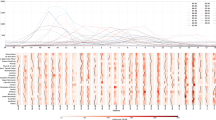Abstract
Many countries now have epidemiological surveillance systems using health services-based indicators that allow detection of influenza epidemics. However, there is no accepted criterion for defining an influenza epidemic. An epidemic criterion has been developed, based on a time-series analysis of health services-based indicators collected on a weekly basis by a surveillance network implemented in the Paris region since 1984: the Groupe Régional d'Observation de la Grippe (GROG). For each new season, an epidemic threshold is independently defined for each health services-based indicator as the upper limit of the one-sided confidence interval of the expected value calculated from the weekly differences between the observed number of events and those predicted by a SARIMA model fitted on the non-epidemic data of previous seasons. Epidemic criteria for influenza A and B are then defined from the combination of both viral indicators and epidemic thresholds of individual health services-based indicators. Among health indicators, sick-leave data collected from GP's or the Health Insurance system, emergency home medical visits, and influenza-like-illness reported by GP's are the most sensitive indicators for the early recognition of epidemics. The exceeding of the above mentioned thresholds combined with virological data allows the specific detection of influenza A or B epidemics. This time-series method of analysing surveillance data provides early and reliable recognition of these epidemics.
Similar content being viewed by others
References
MMWR. Influenza activity–United States, 1989–1991. MMWR 1991;40:809–810.
Housworth J, Langmuir AD. Excess mortality from epidemic influenza, 1957–1966. Am J Epidemiol 1974; 100: 40–48.
Jensen KE, Hogan RB. Laboratory diagnosis of Asian influenza. Public Health Rep 1958; 73: 140–144.
Thacker SB. The persistence of influenza A in human populations. Epidemiol Rev 1986; 8: 129–142.
Hope-Simpson RE. Epidemic mechanisms of type A influenza. J Hyg Camb 1979; 83: 11–26.
Stuart-Harris CH. Epidemiology of influenza in man. Br Med Bull 1979; 35: 3–8.
Thacker SB, Stroup DF. Persistence of influenza A by continuous close-contact transmission: The effect of non-random mixing. Int J Epidemiol 1990; 19: 1078–1082.
Neustadt RE, Fineberg HV, Califano JA. The swine flu affair. Decision-making on a slippery disease. Washington, United States Department of Health, Education, and Welfare, 1978.
Serfling RE. Methods for current statistical analysis of excess pneumonia-influenza deaths. Public Health Rep 1963; 78: 494–506.
Choi K, Thacker SB. An evaluation of influenza mortality surveillance 1962–1979. I. Time series forecasts of expected pneumonia and influenza deaths. Am J Epidemiol 1981; 113: 215–226.
Choi K, Thacker SB. An evaluation of influenza mortality surveillance, 1962–1979. II. Percentage of pneumonia and influenza deaths as an indicator of influenza activity. Am J Epidemiol 1981; 113: 227–235.
Perrotta DM, Decker M, Glezen WP. Acute respiratory disease hospitalizations as a measure of impact of epidemic influenza. Am J Epidemiol 1985; 122: 468–476.
Pachucki CT, Walsh Pappas SA, et al. Influenza A among hospital personnel and patients. Arch Intern Med 1989; 149: 77–80.
Buffington J, Chapman LE, Schmeltz LM, et al. Do family physicians make good sentinels for influenza ? Arch Fam Med 1993; 2: 859–864.
Hall CB, Douglas RG. Respiratory syncytial virus and influenza. Practical community surveillance. Am J Dis Child 1976; 130: 615–620.
Costagliola D, Flahault A, Galinec D, et al. A routine tool for detection and assessment of epidemics of influenza-like syndromes in France. Am J Public Health 1991; 81: 97–99.
Campbell DM, Paixao MT, Reid D. Influenza and the 'spotter' general practitioner. J R Col Gen Pract 1988; 38: 418–421.
Welliver RC, Cherry JD, Boyer KM, et al. Sales of nonprescription cold remedies: a unique method of influenza surveillance. Pediatr Res 1979; 13: 1015–1017.
Hannoun C, Dab W, Cohen JM. A new influenza surveillance system in France: The Ile-de-France GROG. I. Principles and methodology. Eur J Epidemiol 1989; 5: 285–293.
Dab W, Quénel P, Cohen JM, et al. A new influenza surveillance system in France: The Ile-de-France 'GROG'. II. Validity of indicators (1984–1989). Eur J Epidemiol 1991; 7: 579–587.
Quénel P, Dab W, Hannoun C, et al. Sensitivity, specificity and predictive values of health service based indicators for the surveillance of influenza A epidemics. Int J Epidemiol 1994; 23: 849–855.
SAS/ETS. User's Guide, Version 5 Edition, 1984.
Box GEP, Jenkins GM. Time series analysis: Forecasting and control. San Francisco: Holden Days, 1976.
Ljung GM, Box GEP. On a measure of lack of fit in time series models. Biometrika 1978; 65: 297–303.
Akaike H. On the likelihood of a time series model. Statistician 1978; 27: 215–235.
Choi K, Thacker SB. Improved accuracy and specificity of forecasting deaths attributed to pneumonia and influenza. J Infect Dis 1981; 144: 606–608.
Chatfield C, Prothero DL. Box-Jenkins seasonal forecasting: Problems in a case-study. J R Stat Soc 1973; 136: 295–336.
Quénel P, Dab W, Cohen JM, Hannoun C. Le groupe régional d'observation de la grippe en Ile-de-France: Cinq ans d'expérience. Santé Publ 1991; 6: 46–53.
Douglas RG. Prophylaxis and treatment of influenza. N Engl J Med 1990; 332: 443–450.
Author information
Authors and Affiliations
Rights and permissions
About this article
Cite this article
Quénel, P., Dab, W. Influenza A and B epidemic criteria based on time-series analysis of health services surveillance data. Eur J Epidemiol 14, 275–285 (1998). https://doi.org/10.1023/A:1007467814485
Issue Date:
DOI: https://doi.org/10.1023/A:1007467814485




